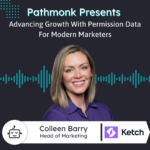
Introduction
In this enlightening episode, we welcome Erik Charles, VP of Marketing at Dispatch Track, the global leader in last mile delivery software.
Erik shares valuable insights into the challenges and solutions in the world of logistics and delivery optimization. From furniture to fresh food, Erik explains how Dispatch Track’s software revolutionizes route planning, improves fuel efficiency, and enhances customer satisfaction. He also dives into the intricacies of marketing in the logistics industry, discussing lead generation strategies, the importance of website analytics, and the ongoing challenge of attribution in marketing.
This episode is a must-listen for anyone interested in the intersection of technology, logistics, and marketing.
Increase +180%
leads
demos
sales
bookings
from your website with AI
Get more conversions from your existing website traffic delivering personalized experiences.

Ernesto Quezada: Pathmonk is the intelligent tool for website lead generation. With increasing online competition, over 98% of website visitors don’t convert. The ability to successfully show your value proposition and support visitors in their buying journey separates you from the competition online. Pathmonk qualifies and converts leads on your website by figuring out where they are in the buying journey and influencing them in key decision moments. With relevant micro-experiences like case studies, intro videos, and much more, stay relevant to your visitors and increase conversions by 50%. Add Pathmonk to your website in seconds. Let the AI do all the work and get an extra 50% more qualified leads while you keep doing marketing and sales as usual. Check us out on pathmonk.com. Welcome to today’s episode. Let’s talk about today’s guest. We have Erik from Dispatch Track, VP of Marketing with them. How are you doing today, Erik?
Erik Charles: I’m doing great. It’s a beautiful day right now.
Ernesto: Awesome. Great. Well, great to hear that. And, well, Erik, I’m sure our listeners are tuning in wondering what Dispatch Track is all about. So, in your own words, tell us a little bit more.
Erik: When was the last time you ordered a couch? Or maybe a new refrigerator? Or maybe you were driving by a construction site and saw someone pulling up with a truckload of gear, or you’re going to your favorite restaurant wondering why today’s special is that amazing bit of lobster? That is all last-mile delivery. Dispatch Track is the global leader in last-mile delivery software, helping both internal or third-party logistics companies get the right packages to customers efficiently. This is software for deliveries, which is kind of funny because I’ve been listening to your podcast for a while. One of the things I love about what I’m working on at Dispatch Track is that it’s a highly sophisticated business that a lot of Silicon Valley oftentimes overlooks.
Ernesto: Okay, interesting. So that way, then, our listeners can get a good understanding of your company. Erik, what would you say is the key problem that you guys like to solve at Dispatch Track for clients?
Erik: Sure. Have you looked at the price of gas recently? Whether diesel, regular, or even the cost of charging up an electric delivery vehicle, route optimization is really important. Route optimization ensures trucks aren’t driving in circles or going to the wrong place. To give you an idea, the cost of the last mile—meaning from the local warehouse to the buyer—has risen from 41% to 53% of overall delivery costs. So if I can at minimum get a truck to drive fewer miles and/or do more deliveries in a day, that’s directly to the bottom line.
Ernesto: Okay, interesting. I like that. So then, not to assume, but what’s the main vertical segment? What’s the ICP for you guys?
Erik: That’s a fun one. Our ICP started in furniture, and we really cut our teeth there. Think big, bulky furniture—delivery trucks that can’t drive a semi into a neighborhood. So you need trucks with routing that’s a little different than a car. Maybe I’m dropping off several Aeron chairs, a stand-up desk, or a boardroom table. You can’t send a driver out with just one delivery, so they’ll likely have two or three stops in a day. You want to avoid zigzagging, and truck routing is a little different from driving a car. You don’t want to turn left with a delivery truck in San Francisco at 3:00 PM or in Manhattan, for example. So, by optimizing routes, you reduce fuel charges and get more deliveries done in a day.
Ernesto: Yup, that’s the main goal—reducing costs or increasing productivity. So, how would someone usually find out about Dispatch Track? Is there a top client acquisition channel for you?
Erik: We get a ton of inbound. Going back to furniture, we get great inbound from that industry. People search for route optimization, delivery times, last-mile logistics, etc. We also get inbound from people looking to improve their net promoter score or customer success factors. For example, someone in fresh food delivery might ask, “Can you help us with deliveries to restaurants?” We got into fresh food because people wanted route optimization for things like scheduled deliveries for fresh fish or seafood at specific times. We do a lot with professional associations, conferences, and direct networking as well, which is very important for us in this industry.
Ernesto: Got it. Awesome. And for our listeners who want to visit you, they can check you out at dispatchtrack.com. What role does the website play for client acquisition?
Erik: Oh, man, I was just auditing this recently. We get a ton of traffic, so I’m always checking metrics—bounce rates, time on pages. We have classic demo requests and assets, but we’re also having discussions about which assets to gate with a form. Sometimes people bounce when they see a form fill, so I want them to have content they can read but still lead them toward a gated asset for those who want it. We have a traditional SDR team to follow up on inquiries and make sure we’re supporting their needs.
Ernesto: Definitely important. So on that note, are there any tools or methods you’re implementing that you’d recommend to our listeners?
Erik: Well, I could say attribution because that’s every marketer’s headache, right? We work on identifying inbounds accurately, like where exactly people are coming from. For events, I like to see website traffic spikes after an event. Sometimes I even check how much traffic comes during an industry event to see if people are looking us up right then and there.
Ernesto: Okay, I like that. Thanks for sharing that. And let’s switch gears to talk about you as a leader. What are some key tasks you focus on in your day-to-day as VP of Marketing?
Erik: It changes all the time, but when I first join a company, I start by reading the content, asking, “Are we capturing the value in our messaging?” Then I dig into the data—what’s generating MQLs, what’s converting to SALs, and how these align with sales expectations. I want reports that match sales numbers to avoid that “marketing versus sales” nightmare, so I work closely with revenue operations. I always make sure my reports align with sales metrics to avoid discrepancies.
Ernesto: Awesome. And now let’s jump into our rapid-fire questions. Are you ready?
Erik: Okay, let’s go.
Ernesto: First off, what’s the last book you read?
Erik: I’m a classic “stack of books” person, but I recently read Pre-suasion on performance marketing and Conflict by David Petraeus, a history of warfare from WWII to Ukraine.
Ernesto: Interesting reads! Next, if there were no boundaries in technology, what’s one thing you’d fix in marketing today?
Erik: Attribution—being certain about what drives traffic and which opportunities matter. Technology should make it easier to track the buyer journey precisely.
Ernesto: Definitely. Next, if there’s one repetitive task you could automate, what would it be?
Erik: Account enhancement. When I scan a badge at an event, I want a system to quickly pull up all key players and match them to my content pieces by Persona and industry.
Ernesto: Lastly, with your experience in marketing, what advice would you give yourself if you were starting over?
Erik: I wish I’d taken statistics earlier and learned how to better explain why brand, events, and the harder-to-quantify aspects of marketing matter.
Ernesto: Great advice. And we’re coming to the end of the show, but before we do, if someone forgets everything else, what’s the one thing they should remember about Dispatch Track?
Erik: We’ll make your deliveries happen on time, efficiently, and make your customers happier with the experience.
Ernesto: Great. Listeners, check them out at dispatchtrack.com, the global leader in last-mile delivery software. Erik, thank you so much for joining us, and to our listeners, thank you for tuning in. Looking forward to our next episode on Pathmonk Presents. Thanks, Erik.
Erik: Thank you. Have a great day.











